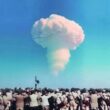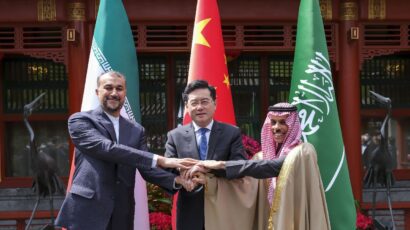Right idea, tricky implementation
By Manpreet Sethi, June 6, 2013
In the context of offering a fresh assessment of the nuclear threats facing the United States, the 2010 US Nuclear Posture Review placed the prevention of nuclear proliferation and nuclear terrorism at the top of the country's nuclear agenda, higher on the list than maintaining strategic deterrence, strengthening regional deterrence, and sustaining a safe, secure, and effective nuclear arsenal. This is not surprising, considering how preoccupied the United States has been in recent years about the risk that terrorists might gain access to nuclear weapons or that states like North Korea or Iran could provoke a cascade of proliferation. Indeed, these two risks are linked, as proliferation increases the chances that non-state actors might gain access to nuclear material.
The United States appears to be addressing these threats on two levels: the tactical and the strategic. The tactical approach has four components: accelerating efforts to secure vulnerable nuclear materials worldwide; disrupting terrorist networks by targeting their financing channels and eliminating their leadership; buttressing homeland security through better border controls and missile defenses and an ability to promptly strike time-sensitive terrorist targets at a distance; and, as outlined in the Nuclear Posture Review, threatening "to hold fully accountable any state, terrorist group, or other non-state actor that supports or enables terrorist efforts to obtain or use weapons of mass destruction."
At the strategic level, though, US policy attempts to address nuclear dangers by reducing the role of nuclear weapons in national security strategy. The Nuclear Posture Review, for example, circumscribed the use of nuclear weapons to "extreme circumstances to defend the vital interests of the United States or its allies and partners." It also contained a vow not to use, or threaten to use, nuclear weapons against non-nuclear weapon states that are party to the Nuclear Non-Proliferation Treaty (NPT) and are in compliance with their nonproliferation obligations. The idea behind both these measures is that nuclear weapons will become less attractive to other countries and the nonproliferation regime will garner additional support.
Are these tactical and strategic approaches contradictory? Is threatening to attack states that abet terrorists incompatible with the goal of reducing nuclear stockpiles and moving toward disarmament? Certainly not. To begin with, the US threat "to hold fully accountable" those who support terrorist efforts to gain weapons of mass destruction does not necessarily mean the United States would use nuclear weapons in such situations. Even the US initiative known as Prompt Global Strike, which would enable the United States military to strike any point on the planet in about an hour, is based on delivering conventional weapons with strategic delivery systems. Meanwhile, the new restrictions that the United States has placed on its own use of nuclear weapons are clearly aimed at devaluing nuclear weapons — at buttressing nonproliferation efforts by taking meaningful action toward disarmament. Therefore, in principle, US policy is on the right track. The problem lies in implementation.
US efforts to deter terrorism, including through nuclear policy, can only succeed if they gain widespread and wholehearted international support. The United States cannot hope to make itself terrorism-proof unless it can convince others that the terrorist danger is urgent and requires many parties to work together. It is here that US policy runs into hurdles. Sometimes the United States finds itself unable to follow through on its own policy. In other situations, its policies can be perceived as threatening and can complicate interstate relations.
Pakistan is a country that shows the limitations of US nuclear policy. Despite ample evidence that Pakistan has been involved in nuclear proliferation — and that the army and Inter-Services Intelligence, the most influential elements of Pakistan's state structure, have supported and fomented terrorism — two issues prevent the United States from taking meaningful punitive action. One is that the United States must have Pakistani support for its war in Afghanistan. The other is that Pakistan itself possesses nuclear weapons. Consequently, Washington to a large extent ignores the dangers associated with Pakistan's growing nuclear arsenal and the support that terrorist organizations receive from within Pakistan – even though the possibility that these groups will get their hands on nuclear weapons, including through official complicity, cannot be dismissed. So US nuclear policy discovers its limits when it runs up against a nuclear-armed state where terrorist groups thrive. There are lessons in this that will not be lost on other nations.
Meanwhile, Russia and China perceive as threatening Washington's pursuit of ballistic missile defense and its Prompt Global Strike initiative (things the United States touts as necessary to defend against proliferation and terrorism). The resulting tension not only spoils chances for the three countries to approach common nuclear dangers in a united way, but also legitimizes the strategic modernization efforts of Moscow and Beijing. And as Russia and China seek to redress the imbalance between their military strength and that of the United States, threat perceptions in less powerful nations grow. The obvious casualty in all this is international security.
If the United States is to surmount hurdles such as these, it will have to craft strategies that provide other nations reasons to cooperate with it. The 2010 Nuclear Posture Review made a start by communicating that the size of the US nuclear arsenal would continue to decrease and that the role of nuclear weapons in US national security would decrease as well. The Nuclear Security Summits, a US-led initiative, have done much to raise awareness about nuclear security issues. But more steps are necessary, especially when it comes to building interstate confidence, a sense of common purpose among nations, and a desire to work collectively.
One important step would be to pursue disarmament as vigorously as nonproliferation. At the 2005 and 2010 NPT Review Conferences, non-nuclear weapon states refused to take on additional nonproliferation commitments unless meaningful steps were taken toward disarmament — with the result that little was achieved. Nuclear disarmament itself requires addressing such contentious subjects as ballistic missile defense, conventional arms imbalances, and the weaponization of outer space. These issues may not be directly related to deterring nuclear terrorism, but addressing them properly will create an environment in which deterrence can work better.
Nuclear terrorism and proliferation are dangers to all of humanity. They are not the responsibility of the United States alone. But the United States has long set the world tone in nuclear affairs — and in the nuclear domain, national security is closely tied to international security. Washington's approach to nuclear dangers would find wide acceptance if it were more inclusive, and if the United States were to find legal and political solutions to nuclear challenges rather than relying so strongly on military strategy.
Topics: Nuclear Weapons
Share: [addthis tool="addthis_inline_share_toolbox"]














